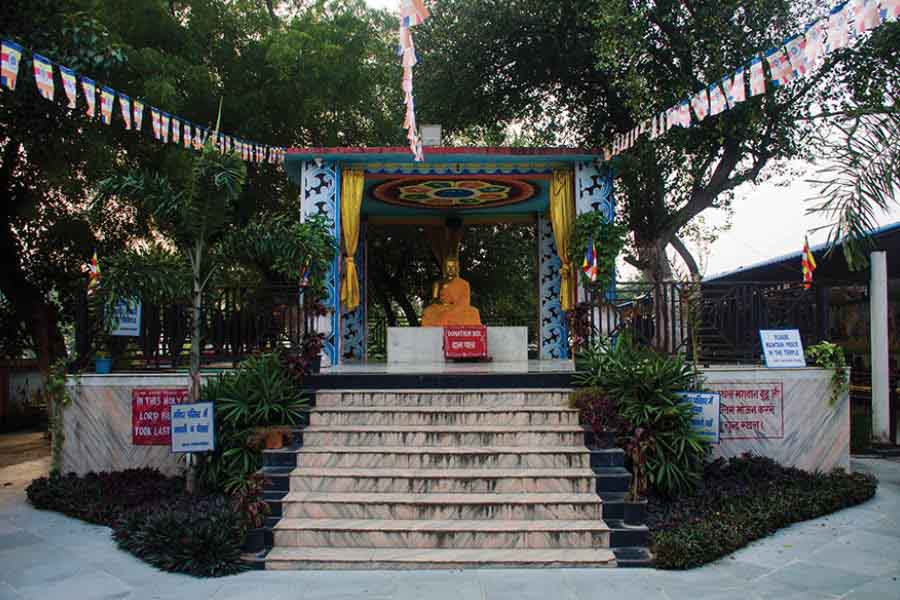Kushinagar is the place where Gautam Buddha chose to die and attend mahaparinirvan — the Sanskrit term which means nirvana after death. Today, Kushinagar is a small sleepy hamlet in Uttar Pradesh, not far from the Nepal border. A short distance across the border in Nepal lies Lumbini, where Gautam Buddha was born.
Kushinagar is an important Buddhist pilgrimage and consists of several archaeological sites along with several other sites related to the last days and death rituals of Buddha. It also houses a series of new Buddhist temples and shrines built by different countries and regions with Buddhist connect.
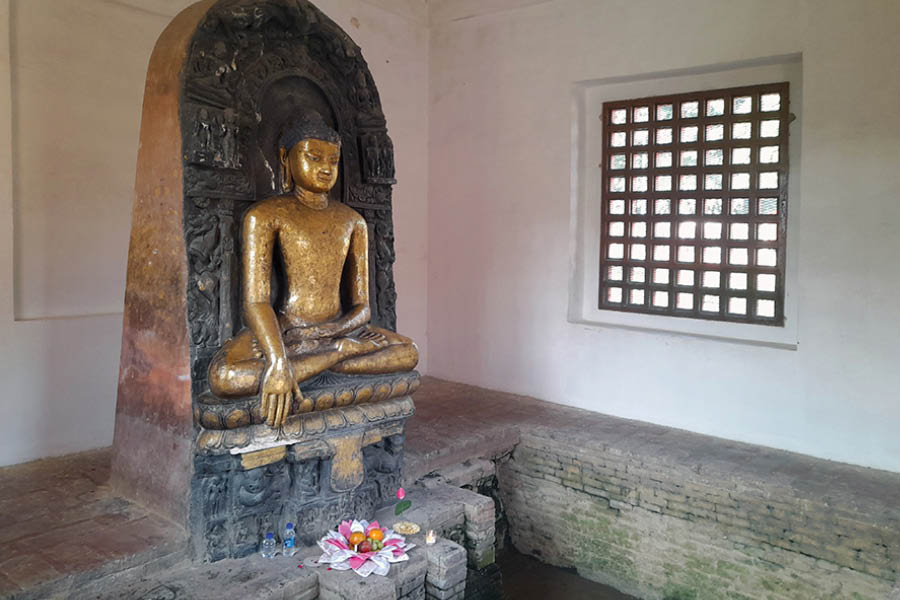
A golden statue of Buddha at the Matha Kuar Shrine
Place of Last Meal
The story of Buddha’s starts from Faizal Nagar (or Fazilnagar) located around 20km east of Kushinagar. Buddha spent his last days in Shravasti, presently a Buddhist pilgrimage site in Uttar Pradesh. When his last days were approaching, he decided to move to some location suitable for his mahaparinirvana. He moved to a mango grove where he was offered a meal by a blacksmith named Chunda. The place was then called Pawa Nagar and is present-day Faizal Nagar. There are two theories on the type of food offered to him. One claims it to be pork, while other claim it to be wild mushroom. Strangely, the food was offered only to Buddha and not his disciples. Buddha fell ill after the meal and had severe dysentery. He didn’t blame Chunda, rather valued the meal as the kheer offered by Sujata immediately after his enlightenment in Bodh Gaya.
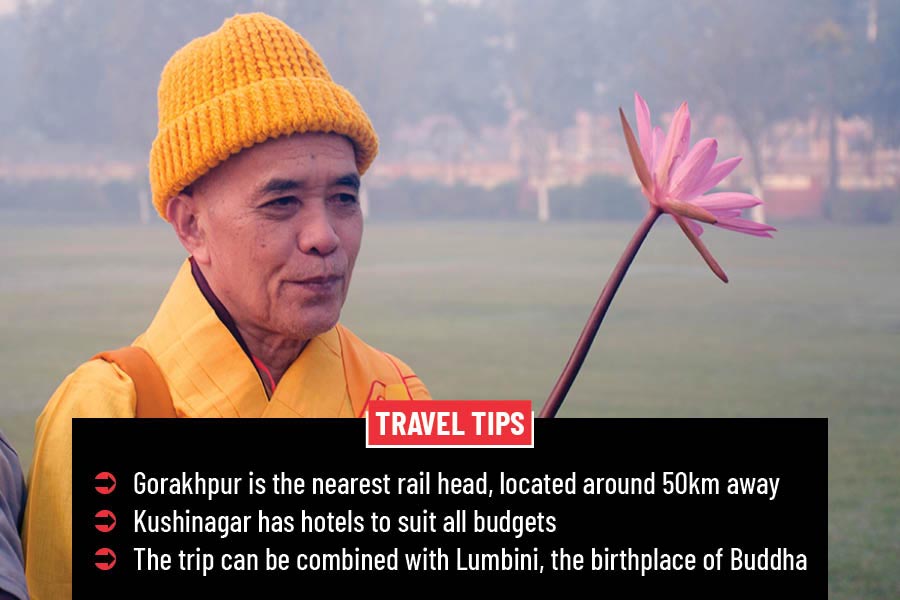
Sadly, nothing remains of the place where he had his last meal. In recent years, a statue of Buddha is installed in the very place where Buddha is supposed to have had his last meal. The seated statue of Buddha is housed on an elevated platform approached by a flight of stairs. It is housed in a walled complex with portion of the inner wall painted with event depicting Buddha’s life.
Timings are from 6am to 6pm. Entry is free and there’s no restriction on photography
Place of last sermon (Matha Kuar Shrine)
In spite of his illness, Buddha decided to travel to Kushinagar. He delivered his last sermon in Kushinagar. He told his followers that he was nearing death and told them to prepare a death bed in the nearby sal forest. Today the site is an archaeological dig and is protected by the Archaeological Survey of India (ASI) and lies on the south western corner of the mahaparinirvan site.
The star attraction of the site is a 3-metre-tall statue of Buddha in bhumisparsha (earth touching) posture which was dug out during the archaeological dig of 1876. The monolithic statue made out of blue stone from Gaya region and was heavily damaged when recovered. It was restored and was enshrined in a temple like structure in 1927. In front of the shrine is a remains of a Buddhist vihar.
Timings are from 6am to 6pm. Entry is free. There’s no restriction on photography
Place of death (Mahaparinirvan)
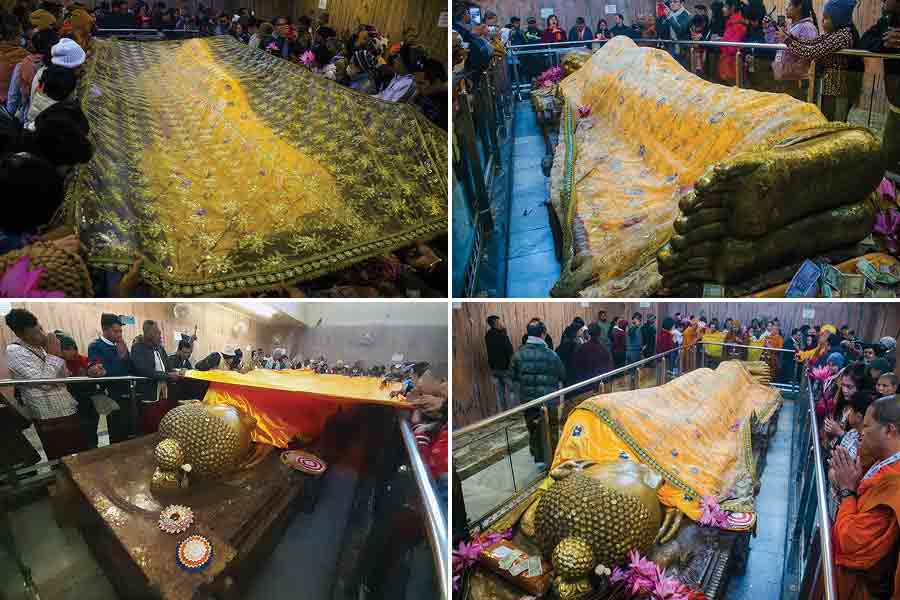
Sheets being spread over the reclining statue inside the Mahaparinirvan temple
A stone’s throw away is the mahaparinirvan site, where Buddha breathed his last. The 1965-built temple stands atop the archaeological ruins. The temple, comprising a shrine and stupa, was built to commemorate the 2,500th anniversary of the death of Buddha. The shrine houses a 6.1-metre-long Buddha statue in reclining posture, with the head towards the north. It is made out of a single stone and rests on a stone couch. The statue was discovered in 1877 in a heavily damaged state and fragmented parts. The fragments were joined to create the statue. The temple stands on the ruins of a Buddhist vihar.
The earliest part of the vihar probably dates back to the time of Asoka with subsequent additions by the Kushans (50 -241 CE) and Guptas (320 – 647 CE). Today, it is the centre of attractions in Kushinagar both for pilgrims and tourists. It is visited by hundreds of Buddhist pilgrims who come with large sheets of bright yellow cloth to cover the statue of reclining Buddha.
Timings are from 6am to 6pm. Entry free. Camera is not allowed, mobile photography is allowed
Cremation site (Ramabhar stupa)
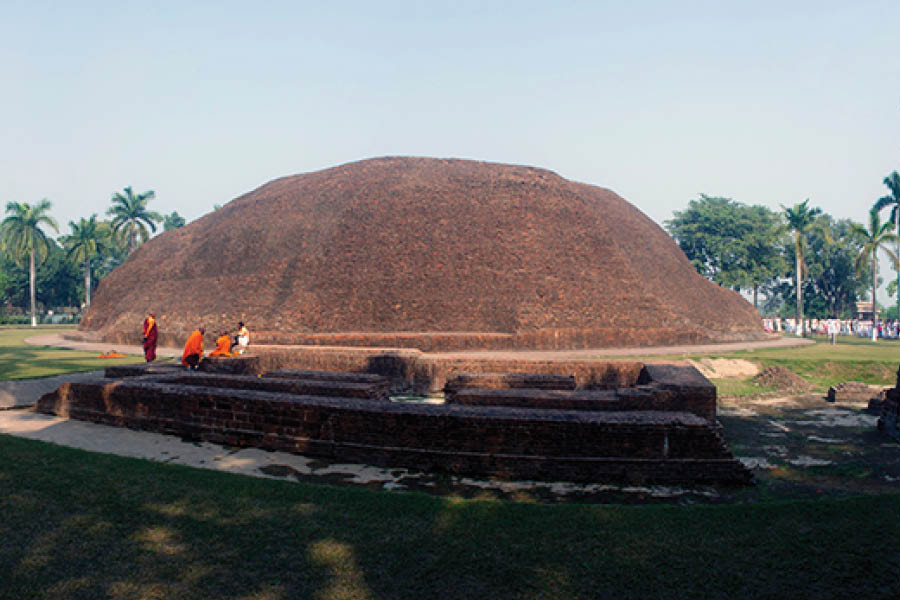
Ramabhar Stupa, cremation site of Buddha
This is located on the eastern end of Kushinagar and believed to the cremation spot of Buddha. The site consists of a huge stupa which was unearthed during an archaeological dig in 1910. The main stupa is surrounded by various other structures including votive stupas along with a large rectangular hall.
Timings are from 6am to 6pm. Entry is free. There’s no restriction on photography
Relic distribution site

The site of distribution of relics
After the cremation, the mortal remains of Buddha were kept as relics and distributed among eight kings of north India. Like the last meal site, this is not an archaeological site. It is located off the road and a lane next to the Thai temple leads to the shrine. The shrine has a small Buddha statue house beneath an ancient banyan tree. A board mentions the names of the eight kings or the dynasties.
Timings are from 6am to 6pm. Entry is free. There’s no restriction on photography
Kushinagar museum
Kushinagar houses a small museum exhibiting artefacts found from nearby archaeological sites. Over 1,300 artefacts are on display, including those made of stone, terracotta and bronze items along with coins and other artefacts.
Timings are from 10.30am to 4.30pm. Ticket is priced at Rs 3. Camera fee is Rs 20
Other temples and shrines

The Chinese Temple, Japanese Temple and the Thailand Temple
Countries like China, Cambodia, Japan, Thailand, Myanmar along with autonomous territories like Tibet have their guesthouses in Kushinagar. All these guesthouses come in with temples, pagodas, stupas and shrines dedicated to Buddha.
The Thailand temple is the largest and has several structures, including a big temple. The golden Myanmar pagoda dominates the Kushinagar skyline. The joint shrine of Japan and Sri Lanka comprise a Buddha statue housed beneath a hemispherical stupa. The Tibetan and Chines have beautiful temples complete with statues and frescoes. Most of the temples are open throughout the day. The gates are usually locked but are opened on request. Thai temple allows only mobile photography for the other temples there is no restriction.


